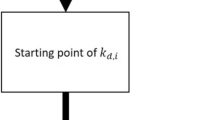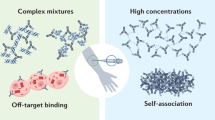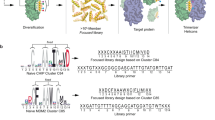Abstract
Enzymes frequently recognize substrates and pharmaceutical drugs through specific binding interactions in deep pockets on the protein surface. We show how the specificity-determining substrate binding site of hen egg-white lysozyme (HEWL) can be readily identified in aqueous solution by nuclear magnetic resonance spectroscopy using small organic solvent molecules as detection probes. Exchange of magnetization between the 1H nuclei of the protein and the ligands through dipole-dipole interactions is observed which allows the modeling of their position and orientation at the binding site. Combined with site-specific binding constants measured by titration experiments with different organic solvents, the method can provide important information for rational drug design. In addition, the lifetime of nonspecific interactions of HEWL with organic solvents is shown to be in the sub-nanosecond time range.
This is a preview of subscription content, access via your institution
Access options
Subscribe to this journal
Receive 12 print issues and online access
$259.00 per year
only $21.58 per issue
Buy this article
- Purchase on SpringerLink
- Instant access to full article PDF
Prices may be subject to local taxes which are calculated during checkout
Similar content being viewed by others
References
Alien, K.N., Bellamacina, C.R., Ding, X., Jeffery, C.J., Mattos, C., Petsko, G.A. et al. 1996. An experimental approach to mapping the binding surfaces of crystalline proteins. J. Phys. Chem. 100: 2605–2611.
Mattos, C. and Ringe, D. 1996. Locating and characterizing binding sites on proteins. Nature Biotechnology 14: 595–599.
Wescott, C.R. and Klibanov, A.M. 1994. The solvent dependence of enzyme specificity. Biochim. Biophys. Acta 1286: 1–9.
Lumb, K.J., Cheetham, J.C., and Dobson, C.M. 1994. 1H nuclear magnetic resonance studies of hen lysozyme-N-acetylglucosamine oligosaccharide complexes in solution. Application of chemical shifts for the comparison of conformational changes in solution and in the crystal. J. Mol. Biol. 236: 1072–1087.
Kelly, J.A., Sielecki, A.R., Sykes, B.D., James, M.N., and Phillips, D.C. 1970. X-ray crystallography of the binding of the bacterial cell wall trisaccharide NAM-NAG-NAM to lysozyme. Nature 282: 875–878.
Cheetham, J.C., Artymiuk, P.J., and Phillips, D.C. 1992. Refinement of an enzyme complex with inhibitor bound at partial occupancy. Hen egg-white lysozyme and tri-N-acetylchitotriose at 1.75 Å resolution. J. Mol. Biol. 224: 613–628.
Hadfield, A.T., Harvey, D.J., Archer, D.B., MacKenzie, D.A., Jeenes, D.J., Radford, S.E. et al. 1994. Crystal structure or the mutant D52S hen egg white lysozyme with an oligosaccharide product. J. Mol. Biol. 243: 856–872.
Maenaka, K., Matsushima, M., Song, H., Sunada, R., Watanabe, K., and Kumagai, I. 1995. Dissection of protein-carbohydrate interactions in mutant hen egg-white lysozyme complexes and their hydrolytic activity. J. Mol. Biol. 247: 281–193.
Ernst, R.R., Bodenhausen, G., and Wokaun, A. 1987. Principles of Nuclear Magnetic Resonance in One and Two Dimensions. Clarendon Press, Oxford.
Yonath, A., Podjarny, A., Honig, B., Traub, W., Sielecki, A., Herzberg, O. et al. 1978. Structural analysis of denaturant-protein interactions: comparison between the effects of bromoethanol and SDS on denaturation and renaturation of triclinic lysozyme. Biophys. Struct. Mech. 4: 27–36.
Lehmann, M.S., Mason, S.A., and Mclntyre, G.J. 1985. Study of ethanol-lysozyme interactions using neutron diffraction. Biochemistry 24: 5862–5869.
Lehmann, M.S. and Stansfield, R.F.D. 1989. Binding of dimethyl sulfoxide to lysozyme in crystals, studied with neutron diffraction. Biochemistry 28: 7028–7033.
Pike, A.C. and Acharya, K.R. 1994. A structural basis for the interaction of urea with lysozyme. Protein Science 3: 706–710.
Imoto, T., Johnson, L.N., North, A.C.T., Phillips, D.C., and Rupley, J.A. 1972. Vertebrate Enzymes, pp. 665–864 in The Enzymes Vol. 7, Boyer, RD. (ed.). Academic Press, New York.
Lumb, K.J. and Dobson, C.M. 1992. 1H nuclear magnetic resonance studies of the interaction of urea with hen lysozyme. Origins of the conformational change induced in hen lysozyme by N-acetylglucosamine oligosaccharides. J. Mol. Biol. 227: 9–14.
Smith, R.J., Williams, D.H., and James, K. 1989. Analysis of the rotational motions of the guanidino group in arginine. J. Chem. Soc. Chem. Commun. 682–683.
Kundrot, C.E. and Richards, P.M. 1987. Crystal structure of hen egg-white lysozyme at a hydrostatic pressure of 1000 atmospheres. J. Mol. Biol. 193: 157–170.
Bernstein, F.C., Koetzle, T.R., Williams, G.J.B., Meyer, E.F. Jr., Brice, M.D., Rodgers, J.R. et al. 1977. The protein data bank: a computer-based archival file for macromolecular structures. J. Mol. Biol. 112: 535–542.
Otting, G., Liepinsh, E., and Wüthrich, K. 1991. Protein hydration in aqueous solution. Science 264: 974–980.
Otting, G. and Liepinsh, E. 1995. Protein hydration by high-resolution NMR spec-troscopy—Implications for MR image contrast. Acc. Chem. Res. 28: 171–177.
Eigen, M. and Hammes, G.G. 1963. Elementary steps in enzyme reactions. Adv. Enzym. 25: 1–38.
Briand, J. and Ernst, R.R. 1991. Computer-optimized homonuclear TOCSY experiments with suppression of cross relaxation. Chem. Phys. Lett. 186: 276–285.
Redfield, C. and Dobson, C.M. 1988. Sequential 1H NMR assignments and secondary structure of hen egg white lysozyme in solution. Biochemistry 27: 122–136.
Bodenhausen, G., Kogler, H., and Ernst, R.R. 1984. Selection of coherence-transfer pathways in NMR pulse experiments. J. Magn. Reson. 58: 370–388.
Geen, H. and Rreeman, R. 1991. Band-selective radiofrequency pulses. J. Magn. Reson. 93: 93–141.
Otting, G., Liepinsh, E., Farmer II, B.T., and Wuthrich, K. 1991. Protein hydration studied with homonuclear 3D 1H NMR experiments. J. Biomol. NMR 1: 209–215.
Otting, G., Liepinsh, E., and Wuthrich, K. 1992. Protein hydration in mixed solvents at low temperatures. J. Am. Chem. Soc. 114: 7093–7095.
Liepinsh, E. and Otting, G. 1994. Specificity of urea binding to proteins. J. Am. Chem. Soc. 116: 9670–9674.
Xia, T.H., Ph, D. 1992. Thesis no. 9831, ETH Zürich, Switzerland.
Ferrin, T.E., Huang, C.C., Jarvis, L.E., and Langridge, R. 1988. The MIDAS display system. J. Mol. Graphics 6: 13–27.
Author information
Authors and Affiliations
Rights and permissions
About this article
Cite this article
Liepinsh, E., Otting, G. Organic solvents identify specific ligand binding sites on protein surfaces. Nat Biotechnol 15, 264–268 (1997). https://doi.org/10.1038/nbt0397-264
Received:
Accepted:
Issue date:
DOI: https://doi.org/10.1038/nbt0397-264
This article is cited by
-
The multi-copy simultaneous search methodology: a fundamental tool for structure-based drug design
Journal of Computer-Aided Molecular Design (2009)
-
Managing the solvent water polarization to obtain improved NMR spectra of large molecular structures
Journal of Biomolecular NMR (2005)
-
NMR identification of hydrophobic cavities with ow water occupancies in protein structures using small gas molecules
Nature Structural & Molecular Biology (1997)



